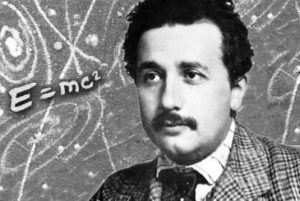Special Relativity is a theory proposed by Albert Einstein that attempts to explain the relationship between space, time and motion. Einstein outlined his proposal in a scientific paper titled “On the Electrodynamics of Moving Bodies” published on September 26th, 1905.
Approaching the Limits of Classical Physics

Isaac Newton’s laws of motion were a wildly successful explanation of the physics of motion, and a dominate force in scientific understanding of physics for over two centuries. However, by the turn of the 20th century some critical shortcomings in the explanatory power of Newton’s famous laws were becoming evident. One of the major phenomena classical physics couldn’t explain was the behavior of light. Classical physics assumes that space and time are absolute and that the speed of light is invariant. It is simply added to or subtracted from the speed of a light source. However, experimental evidence, particularly from the Michelson-Morley experiment of 1887, which demonstrated that the speed of light in a vacuum is independent of the motion of the Earth about the Sun, suggested this is not the case. Their experiments suggested that the speed of light is constant for all observers, regardless of the speed they are traveling at.
Working out a Swiss patent office, the 26-year old Einstein solved these problems with his Theory of Special Relativity and later his Theory of General Relativity. Special relativity describes motion at a constant speed traveling in a straight line (a special case of motion, hence the name) while general relativity describes accelerating motion. Interestingly, his famous equation E=mc^2 did not actually appear in the original paper but was added essentially as an addendum a few months later.
Einstein’s Theory of Special Relativity is based on two principles:
- The laws of physics are the same in all inertial frames of reference
- The speed of light is the same in all inertial frames of reference (186,000 miles/second)
This implies that an observer at rest observes light traveling at a speed of 186,000 miles/second while another observer traveling at 180,000 miles/second relative to the observer at rest also observes light traveling at 186,000 miles/second. Based on these principles several interesting conclusions can be worked out. These conclusions are, or course, relative to an observer at “rest.”
- Time slows as speed increases
- Mass increases as speed increases.
- Mass and energy are equivalent as exemplified through Einstein’s famous E=Mc^2 equation
- The length of an object contracts as speed increases
Testing the Theory and Acceptance
As unlikely as these conclusions seem they have been verified repeatedly through many experiments. The conclusions seem counter-intuitive because many of these effects are only perceptible at near-light speeds. Perhaps this is why the acceptance of special relativity was not immediate and was met with harsh criticism by many scientists. The idea that measurements of time and length could change with velocity conflicted with everyday experiences. However, the aesthetic beauty of its mathematics initially attracted interest among some scientists, prompting further inquiry.
The tide of acceptance began to turn as the predictive power of special relativity was confirmed by experimentation. The most famous example was the 1919 solar eclipse experiment, led by Sir Arthur Eddington, where light was shown to bend around the mass of the sun. This experiment was more about general relativity, however the success of general relativity helped to bolster the acceptance of its counterpart, special relativity.
Experimental confirmation also came from the field of atomic physics. The most famous and direct experimental verification came through nuclear reactions in 1932, when James Chadwich discovered the neutron. Subsequent experiments in atomic physics with experiments involving nuclear fission and fusion continued to confirm the validity of E=mc^2.
Another famous experiment that validated special relativity was a time dilation experiment done in 1971 using high precision atomic clocks flown on commercial airlines. By comparing the time measured by the atomic clocks on the airplanes to those on the ground, experimenters confirmed that the clocks on the airplanes ran slightly slower than the stationary clocks on the ground, in accordance with special relativity. Further experiments using particle accelerators and high energy experiments have provided validation by demonstrating the increase in mass and the time dilation of particles moving at relativistic speeds.
By the beginning of the 21st century special relativity has been fully accepted and fully integrated into the fabric of modern physics. It plays a crucial role in the application of many technologies, including the development of GPS, particle accelerators, and nuclear energy.
Continue reading more about the exciting history of science.
Very interesting post! Congratulations on your blog.
Wow, so informative and you’re so right. Time slows but speed increases.
This was a very informative and interesting article to read. It reminded me about my physics class when I was in my Junior High.
Extremely informative. I enjoyed reading it because I love to read interesting posts like this.
Nice article.. Visit http://www.kyakaisehai.com for interesting fact and biography related Post